In this Python tutorial, we will learn how to use a 3-dimensional NumPy array in Python. Also, we will cover these topics.
- Python numpy 3d array slicing
- Python numpy 3d array to 2d
- Python numpy 3d array axis
- Python plot 3d numpy array
- Python 3d list to numpy array
- Python numpy transpose 3d array
- Python numpy sum 3d array
- Python numpy define 3d array
- Python numpy rotate 3d array
- Python numpy 3d example
- Python numpy where 3d array
- Python numpy empty 3d array
- Reshape 3d array to 2d python numpy
- Python numpy initialize 3d array
- Python numpy append 3d array
- Python numpy concatenate 3d array
Note: The arr.ndim will tell us the dimension of the array in Python, This way we can even verify whether our created array is 3D or not.
Python Numpy 3d array
- In this section, we will discuss how to create a 3-dimensional array in Python.
- Numpy provides a function that allows us manipulate data that can be accessed. A three dimensional means we can use nested levels of array for each dimension.
- To create a 3-dimensional numpy array we can use simple numpy.array() function to display the 3-d array.
Example:
Let’s take an example and understand how to create a three-dimensional array with a specific value.
Source Code:
import numpy as np
arr1 = np.array([[[2,17], [45, 78]], [[88, 92], [60, 76]],[[76,33],[20,18]]])
print("Create 3-d array:\n",arr1)
print("The dimension of the array:", arr1.ndim)Here is the implementation of the following given code:
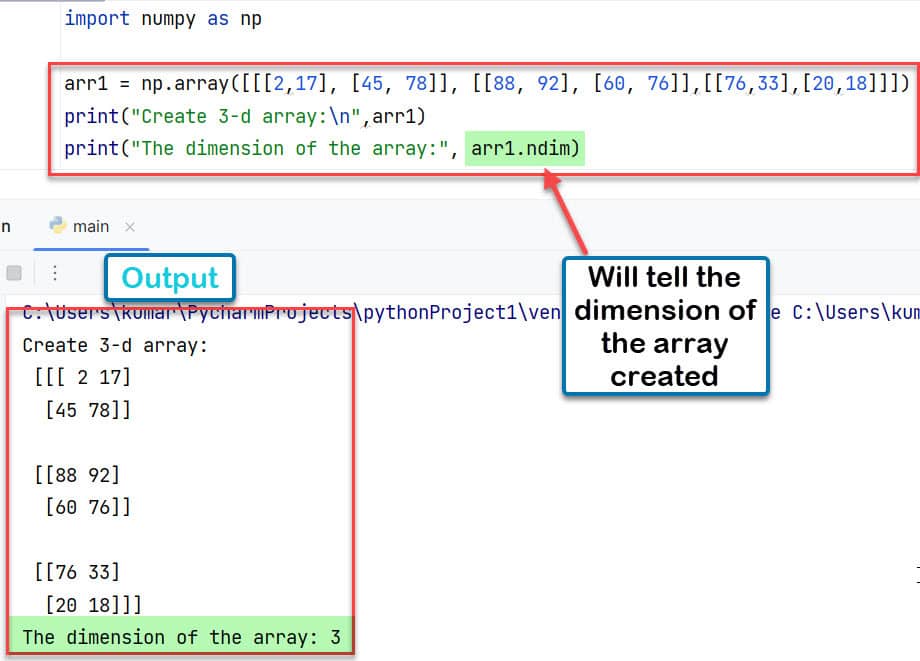
How to create 3d numpy array in Python
By using the NumPy reshape(), we can easily create 3D NumPy array in Python. In Python, this method is used to shape a NumPy array without modifying the elements of the array.
Example:
import numpy as np
new_arr = np.array([[ 78, 23, 41, 66],
[ 109, 167, 41, 28],
[ 187, 22, 76, 88]])
b = new_arr.reshape(3, 2, 2)
print("Created 3D array:\n",b)
print("The dimension of the array:", b.ndim)Output: In the above code first, we have imported the Python NumPy library and then, create an array by using the np.array. Now use the reshape() method, in which we have passed the array shape and size.
Here is the Screenshot of the following given Python code:
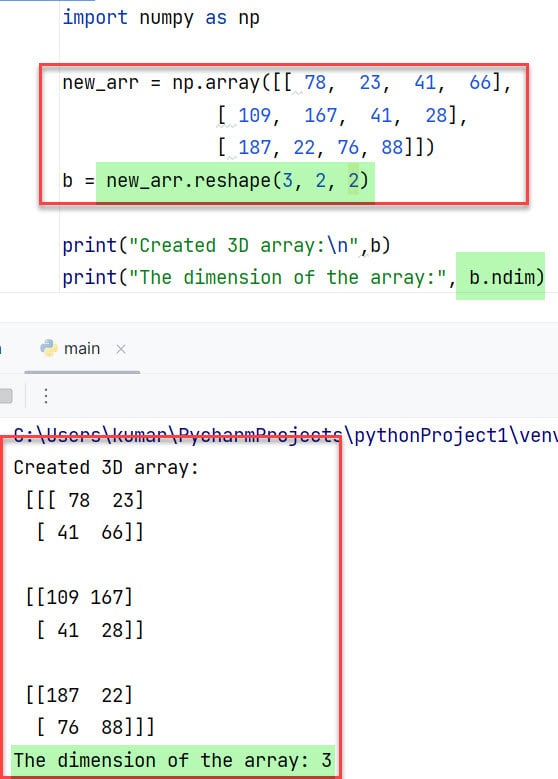
Python numpy 3d array slicing
- In this Program, we are going to discuss how to create a numpy 3d array by using slicing in Python.
- To slice an array in Python we can easily use indexing and in this method take elements from one index to another index.
- In Python the slicing steps are start: end: step. The first parameter is start if we do not pass this parameter in the example then by default it takes as 0. In this case, the end parameter will be considered as the length of the array.
Example:
Let’s take an example and slice elements in a Python NumPy array.
import numpy as np
new_arr2 = np.array([[[178, 189, 567], [145, 239, 445], [197, 345, 678]],
[[56, 78, 190], [46, 10, 11], [6, 2, 1]],
[[45, 118, 203], [72, 119, 34], [87, 9, 5]]])
d= new_arr2[:2,1:,:2]
print("slicing array:\n",d)
print("The dimension of the array:", d.ndim)Output: In the above code, we have just created a simple array and then applied the slicing method to it. In this example, we have selected the length of the array as 2.
Here is the output of the following given code
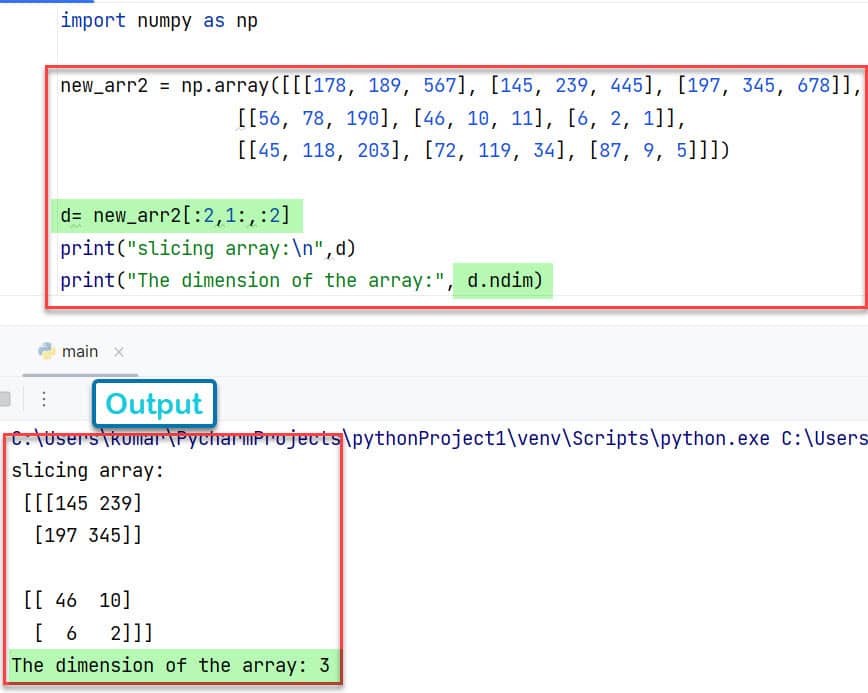
Python Numpy 3d array to 2d
- In this section, we will discuss how to convert a 3-dimensional numpy array to a two-dimensional array in Python.
- To perform this particular task we can use the numpy reshape() method and this function will help the user to reshape a three-dimensional array to a 2D array. In Python reshape means we can easily modify the shape of the array without changing the elements.
Syntax:
Here is the Syntax of numpy.reshape() method
numpy.reshape
(
arr,
newshape,
order='C'
)Source Code:
import numpy as np
new_arr2 = np.array([[[13, 9],
[161, 23]],
[[128, 219],
[109, 992]],
[[42, 34],
[ 128, 398]],
[[236, 557],
[645, 212]]])
b= np.reshape(new_arr2,(4,4))
print("Output array:\n",b)
print("The dimension of the array:", b.ndim)Output: In the above program, we have passed array ‘new_arr’ along with the size of an array (no. of rows and no. of columns). Once you print ‘b’ then, the output will display the new array.
Here is the Screenshot of the following given code:

Python numpy 3d array axis
- In this Program, we will discuss how to create a 3-dimensional array along with an axis in Python.
- Here first, we will create two numpy arrays ‘arr1’ and ‘arr2’ by using the numpy.array() function. Now use the concatenate function and store them into the ‘result’ variable. In Python, the concatenate method will help the user to join two or more numpy arrays of the same shape along with the axis.
- In this example, we set the axis as 0 which represents arrays that have been joined horizontally.
Source code:
import numpy as np
arr1 = np.array([[2,6,7],[16,14,111]])
arr2 = np.array([[73,27,41],[77,21,19]])
result = np.concatenate([[arr1], [arr2]], axis = 0)
print("Output array:\n",result)
print("The dimension of the array:", result.ndim)Here is the output of the following given code:
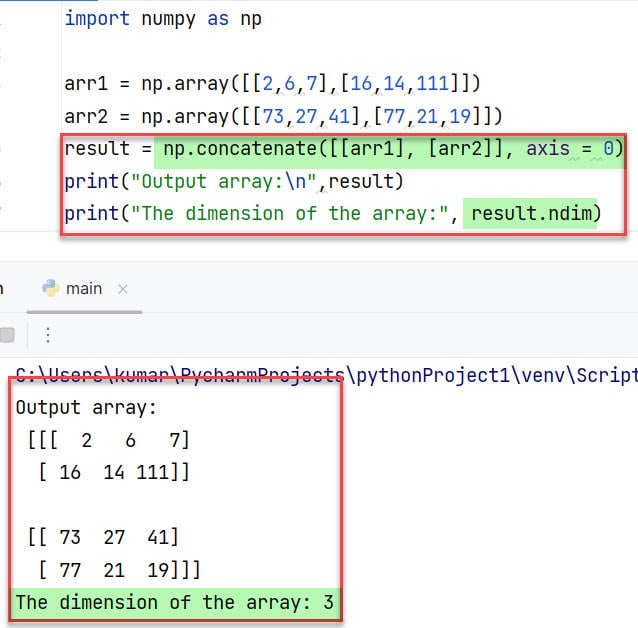
Python plot 3d numpy array
- Here we can see how to plot a 3-dimension numpy array in Python.
- In this example we have imported the matplotlib library for plotting the 3-d graph along with that we have imported the mpl_toolkits module for axes 3d and it is used for adding new axes to it of type axes 3d.
- Here we can define the ‘result’ as a typical subplot with a 3-dimensional projection and then use the slicing method for creating the line object.
- Once you will use plt.figure() then it creates a figure object and plt.show() opens one interactive window that displays our figure.
Source Code:
import matplotlib.pyplot as plt, numpy as np
from mpl_toolkits.mplot3d import Axes3D
arr1= np.array([[52,89,54], [103,423,934], [897,534,118]])
new_val = plt.figure()
result = new_val.add_subplot(122, projection='3d')
result.plot(arr1[:,0],arr1[:,1],arr1[:,2])
plt.show()You can refer to the below Screenshot:
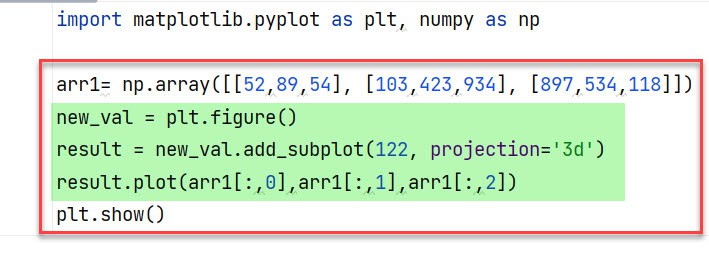
Screenshot of the snippet:
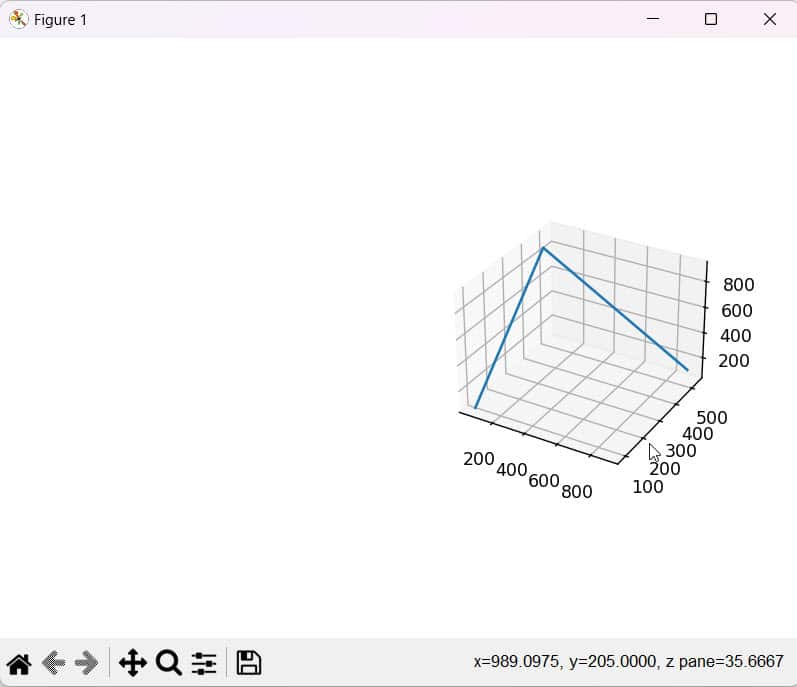
Python 3d list to numpy array
- Let us see how to convert the list into a 3-d numpy array by using Python.
- In this example, we have to convert the list into a 3-dimension array. To do this task we are going to create a list named ‘new_lis’ and then use the np.asarray() method for converting an input list to a numpy array and this function is available in the numpy module.
Syntax:
Here is the Syntax of numpy.asarray() method
numpy.asarray
(
a,
dtype=None,
order=None,
like=None
)Source Code:
import numpy as np
new_lis = [[[23, 45, 278],[ 189, 234, 445],[ 567, 421, 109],[ 18, 21, 188]]]
new_output = np.asarray(new_lis)
print(new_output)
print(new_output.ndim)Here is the implementation of the following given code:
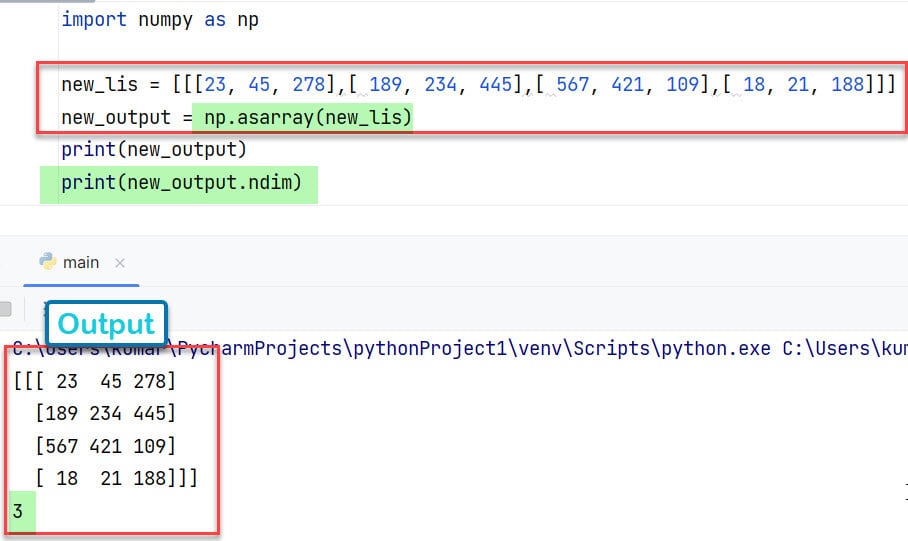
As you can see in the Screenshot the output is a 3-dimension NumPy array in Python.
Python numpy transpose 3d array
- In this section, we will discuss how to transpose a 3-dimension array in Python.
- Here in this example, we have created a simple numpy array in which passes an integer’s value. Now declare a variable ‘result’ and use np.transpose() method. In Python, the np.transpose() method will help the user for changing the row items into column items and similar the column elements into row elements.
- This method can transpose the 3-d array and the output of this method is an updated array of the given one.
Syntax:
Here is the Syntax of numpy.transpose() method
numpy.transpose
(
a,
axes=None
)Example:
Let’s take an example and understand how to transpose a Python numpy 3D array
import numpy as np
new_arr = np.array([[[23,45,21],[24,19,41],[39,84,12]]])
result = np.transpose(new_arr)
print(result)
print(result.ndim)Here is the execution of the following given code:

Python numpy 3d array sum
- In this program, we will discuss how to sum a 3-dimensional numpy array in Python.
- By using the np.sum() method we can solve this problem. In Python, the sum() method sums up the items of an array and within the array object.
Syntax:
Here is the Syntax of np.sum() function
numpy.sum
(
arr,
axis=None,
dtype=None,
out=None,
keepdims=<no value>
initial=<no value>
where=<no value>
)Source Code:
import numpy as np
arr1 = np.array([[[ 56, 24, 16],[ 17, 18, 29],
[64, 16, 18]],
[[ 24, 27, 36],[ 18, 19, 26],
[ 27, 13, 64]]])
b = np.sum(arr1,axis = 0)
print(b)
print("The dimension of the array:", b.ndim)Here is the Screenshot of the following given code:

Python numpy define 3d array
- In this section, we will discuss how to define a numpy 3-dimensional array by using Python.
- To define a 3-d array we can use numpy.ones() method. In Python the numpy.ones() function fills values with one and it will always return a new numpy array of given shape.
Syntax:
Here is the Syntax of numpy.ones() method
numpy.ones
(
shape,
dtype=None,
order='C'
like=None
)Source Code:
import numpy as np
arr1 = np.ones((3, 3, 3))
print(arr1)
print("The dimension of the array:", arr1.ndim)In the above code first, we have to import a NumPy library and then create a variable ‘arr1’ in which we pass np.ones() method for defining a new 3-dimensional array.
Here is the Screenshot of the following given code:

Python numpy rotate 3d array
- Let us see how to rotate a 3-dimensional numpy array in Python.
- By using the np.rot90 we can easily rotate the numpy array in 90 degrees. In Python, this method is used to rotate a NumPy array by 90 degrees.
Syntax:
Here is the syntax NumPy.rot90() method
numpy.rot
(
m,
k=1,
axes=(0,1)
)Source Code:
import numpy as np
arr1 = np.array([[16, 18], [24, 43], [17, 19]])
arr1_3d = np.expand_dims(arr1, axis=0) # Add an extra dimension
print("Original 3D Array:\n", arr1_3d)
rotated_arr = np.rot90(arr1_3d, axes=(1, 2))
print("After rotating the array:\n", rotated_arr)
print("The dimension of the array:", rotated_arr.ndim)You can refer to the below Screenshot:
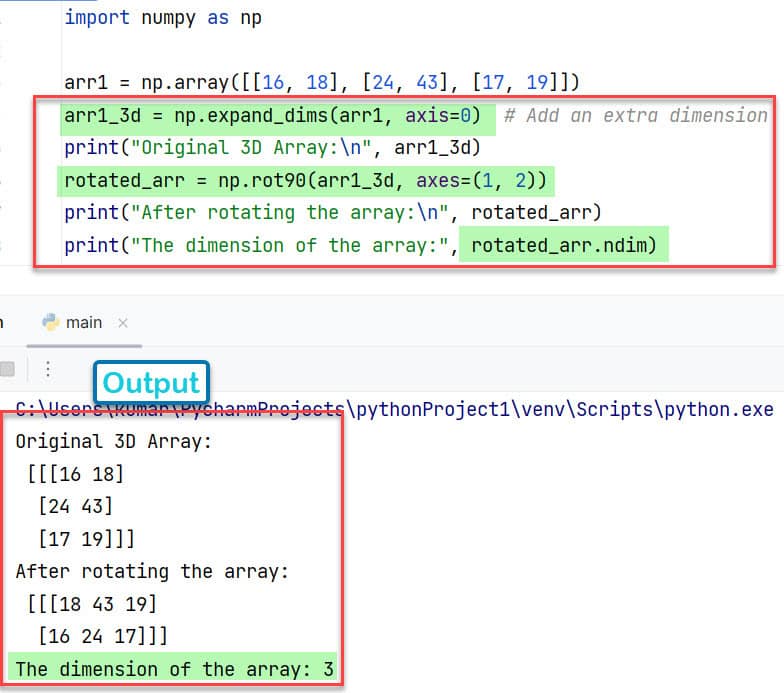
As you can see in the Screenshot the output is the rotation of the array.
Python numpy where 3d array
- Let us see how to use where function in a 3-dimensional array by using Python.
- In Python, this method is used for selecting items based on a condition and it always returns items chosen from X and Y and this function is available in the Python Numpy module.
Syntax:
Here is the Syntax of numpy.where() method
numpy.where
(
condition
[,
x,
y
]
)Example:
import numpy as np
arr1 = np.array([[56, 1, 12], [3, 2, 14],[3,21,5]])
result = np.where(arr1<6)
print(result)
print(arr1[result])In the above code, we have created an array and then use np. where() method in which we assign the condition a<6. Once you will print ‘result’ then the output will display a new 3-dimension array.
Here is the Screenshot of the following given code:
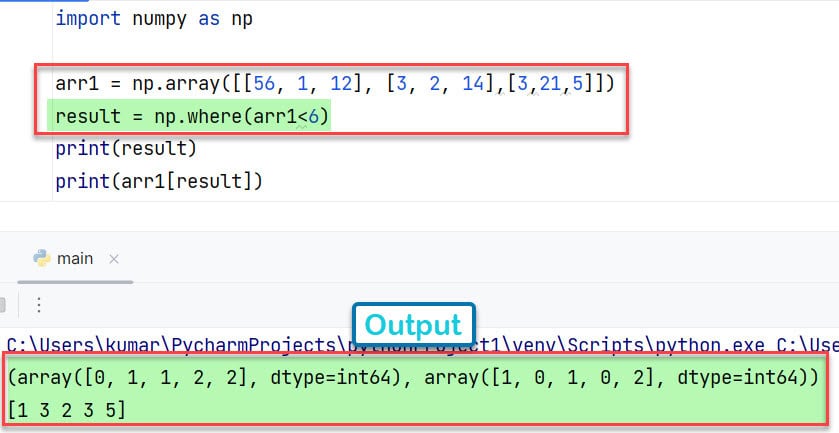
Python numpy empty 3d array
- Here we can see how to create an empty 3-dimension array by using Python.
- In this example, we are going to use an np.empty() method for creating an empty array. In Python, this function does not set the values to zero. It takes only random values.
Syntax:
Here is the Syntax of np.empty() function in Python
numpy.empty
(
shape,
dtype=float,
order='C'
) Note: These parameters define the shape, datatype, and order. It will always return the array of uninitialized data.
Source Code:
import numpy as np
arr1 = np.empty((3, 3, 3))
print(arr1)
print("The dimension of the array created:", arr1.ndim)Here is the execution of the following given code:
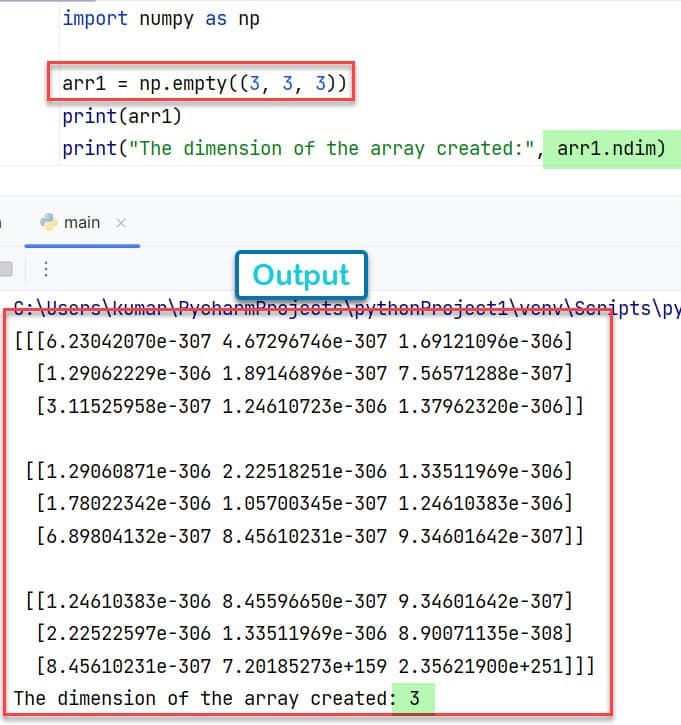
Reshape 3d array to 2d python numpy
- In this Program, we will discuss how to reshape 3-dimensional array to 2-dimensional numpy array in Python.
- In Python reshape means we can easily modify the shape of the array without changing the elements.
Syntax:
Here is the Syntax of NumPy.reshape() method.
numpy.reshape
(
arr,
newshape,
order='C'
)Source Code:
import numpy as np
new_arr2 = np.array([[[42, 16],
[567, 123]],
[[345, 136],
[445, 890]],
[[567, 123],
[789, 908]],
[[678, 908],
[645, 212]]])
result= np.reshape(new_arr2,(4,4))
print(result)Once you will print ‘result’ then the output will display the array of 4*4 dimensions.
Here is the execution of the following given code:
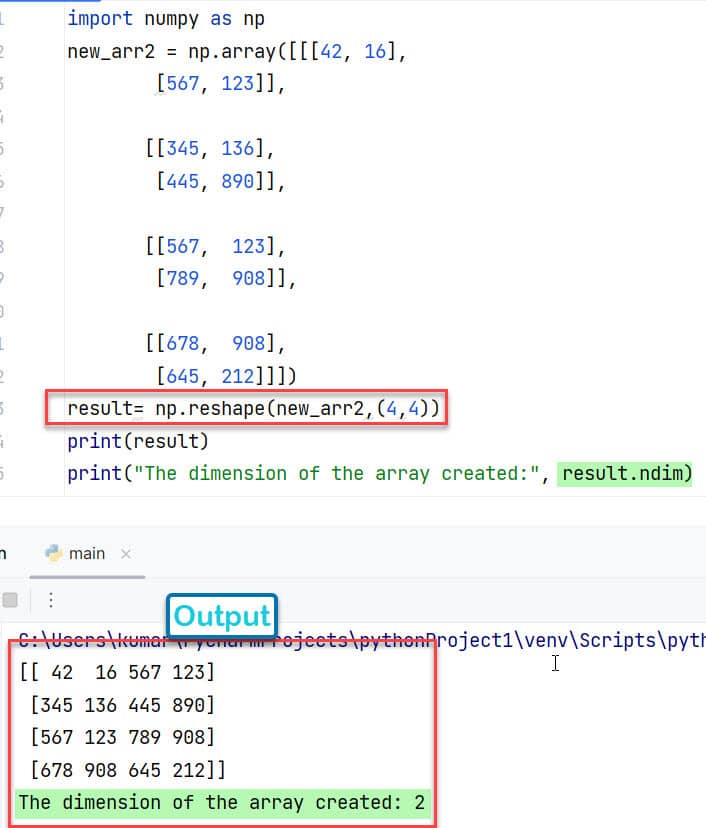
Python numpy initialize 3d array
- In this section, we will discuss how to initialize a 3-dimensional array in Python.
- In Python to initialize a 3-dimension array, we can easily use the np.array function for creating an array and once you will print the ‘arr1’ then the output will display a 3-dimensional array.
Source Code:
import numpy as np
arr1 = np.array([[[4,36], [134, 94]], [[976, 234], [189, 123]],[[56,21],[109,67]]])
print("Initialize 3-d array:",arr1)
print("The dimension of the array initilzed:", arr1.ndim)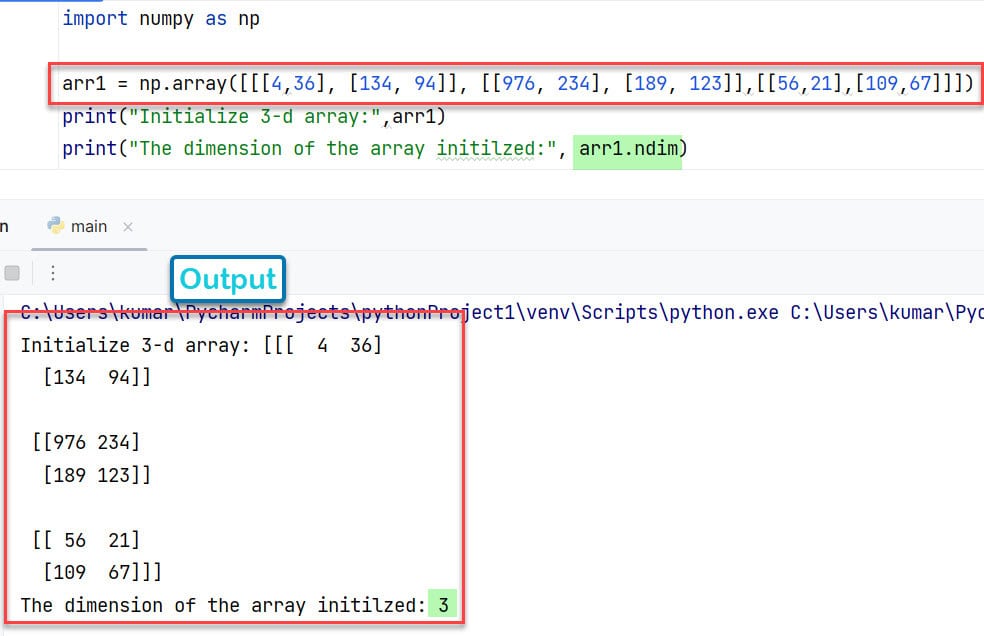
Python numpy append 3d array
- In this section, we will discuss how to append numpy 3d array by using Python.
- In Python, the append() function will add items at the end of an array and this function will merge two numpy arrays and it always returns a new array.
Example:
Let’s take an example and understand how to append a 3-dimensional numpy array in Python
import numpy as np
new_array1 = np.array([[23, 31], [78, 89],[356,921]])
new_array2 = np.array([[834, 567], [179, 119],[823,108]])
result = np.append(new_array1, new_array2,axis=1)
print(result)In the above code, we apply the append() function in which we have assigned two given arrays ‘new_array1’ and ‘new_array2’. Once you will print the ‘result’ then the output will display a new updated 3-dimensional array.
Here is the Screenshot of the following given code:

Python numpy concatenate 3d array
- Let us see how to concatenate a 3-dimensional numpy array by using Python.
- In Python, the concatenate function is used to combine two different numpy arrays along with an axis.
- In this example we have created a two numpy arrays ‘arr1’ and ‘arr2’ by using np.array() function. Now use concatenate function in which we have pass arrays and axis it.
Source Code:
import numpy as np
arr1 = np.array([[67, 23, 89], [15, 35, 76],[114,256,345]])
arr2 = np.array([[48, 189, 234],[782, 567, 190],[543,134,567]])
print(np.concatenate((arr1, arr2), axis = -1))Here is the output of the following given code:
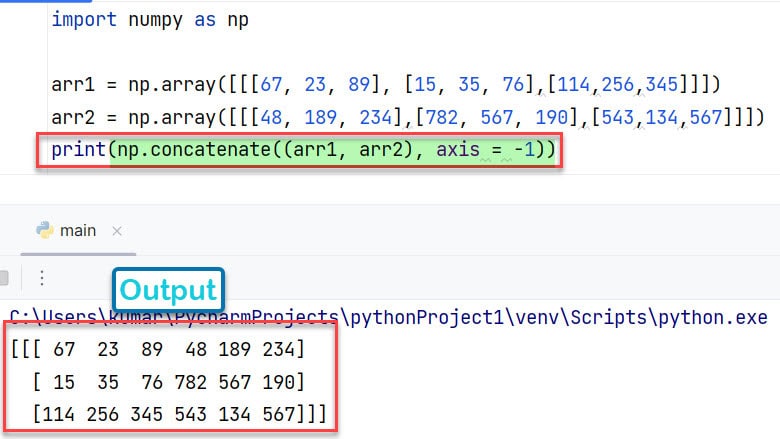
As you can see in the screenshot the output will display a new 3-d array.
You may also like to read the following Python Numpy tutorials.
- Python NumPy Average
- Python NumPy empty array
- Python NumPy shape
- Python NumPy 2d array
- Python NumPy diff
In this Python tutorial, we have learned how to use a 3-dimensional NumPy array in Python. Also, we have covered these topics.
- Python numpy 3d array slicing
- Python numpy 3d array to 2d
- Python numpy 3d array axis
- Python plot 3d numpy array
- Python 3d list to numpy array
- Python numpy transpose 3d array
- Python numpy sum 3d array
- Python numpy define 3d array
- Python numpy rotate 3d array
- Python numpy 3d example
- Python numpy where 3d array
- Python numpy empty 3d array
- reshape 3d array to 2d python numpy
- Python numpy initialize 3d array
- Python numpy append 3d array
- Python numpy concatenate 3d array

I am Bijay Kumar, a Microsoft MVP in SharePoint. Apart from SharePoint, I started working on Python, Machine learning, and artificial intelligence for the last 5 years. During this time I got expertise in various Python libraries also like Tkinter, Pandas, NumPy, Turtle, Django, Matplotlib, Tensorflow, Scipy, Scikit-Learn, etc… for various clients in the United States, Canada, the United Kingdom, Australia, New Zealand, etc. Check out my profile.